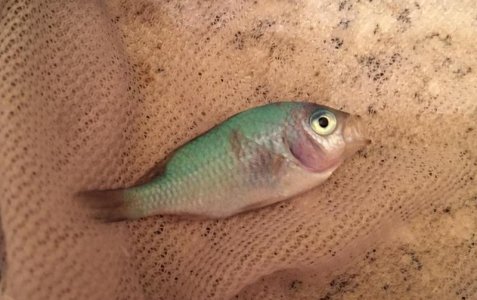EugeneReef
New member
Purchased 5 Chromies on Thursday and they've been in the QT. Yesterday I noticed a dark spot on the back of one of them but it seemed to be eating normally. Today it was dead. Naturally the first thing I think of is Uronema Marinum, is this that? I have a bit of doubt as Uronema is generally described as causing red blotches and this was more of a dark color. Also I didn't notice anything with the slime coat or scales which is supposedly part of it. Could it be an internal outbreak of Uronema? The dark spot is a little hard to see in this pic as it's under his fin. There is also a smaller dark spot above his head I think. Is this definitive enough to tell what caused the death?
Another important piece of info, I had what I am believe was a brooklynella outbreak about three months ago that wiped out all my fish except an my female ocellaris. That female clownfish was treated in this same QT using acriflavine, recovered (though to be honest she never presented symptoms), and I have since had a male clown and a kamohara blenny pass through the QT without getting sick themselves. So I must consider the possibility that this could be the original parasite resurging though it does seem unlikely to me given I have had two other fish who resided in the QT for some weeks without getting sick. Also this other parasite presented very much like brook (ragged slime coat, patchy scales) but I don't really see this in the chromis that died.
Thanks for any insight
Another important piece of info, I had what I am believe was a brooklynella outbreak about three months ago that wiped out all my fish except an my female ocellaris. That female clownfish was treated in this same QT using acriflavine, recovered (though to be honest she never presented symptoms), and I have since had a male clown and a kamohara blenny pass through the QT without getting sick themselves. So I must consider the possibility that this could be the original parasite resurging though it does seem unlikely to me given I have had two other fish who resided in the QT for some weeks without getting sick. Also this other parasite presented very much like brook (ragged slime coat, patchy scales) but I don't really see this in the chromis that died.
Thanks for any insight

